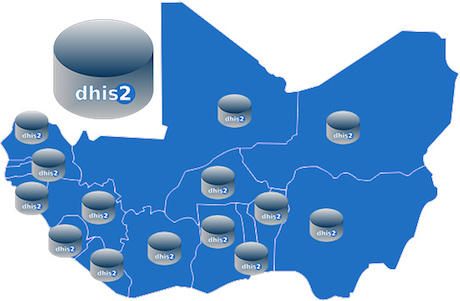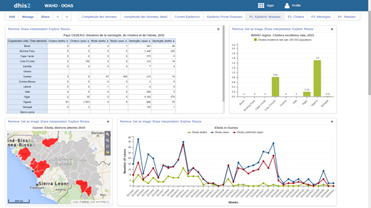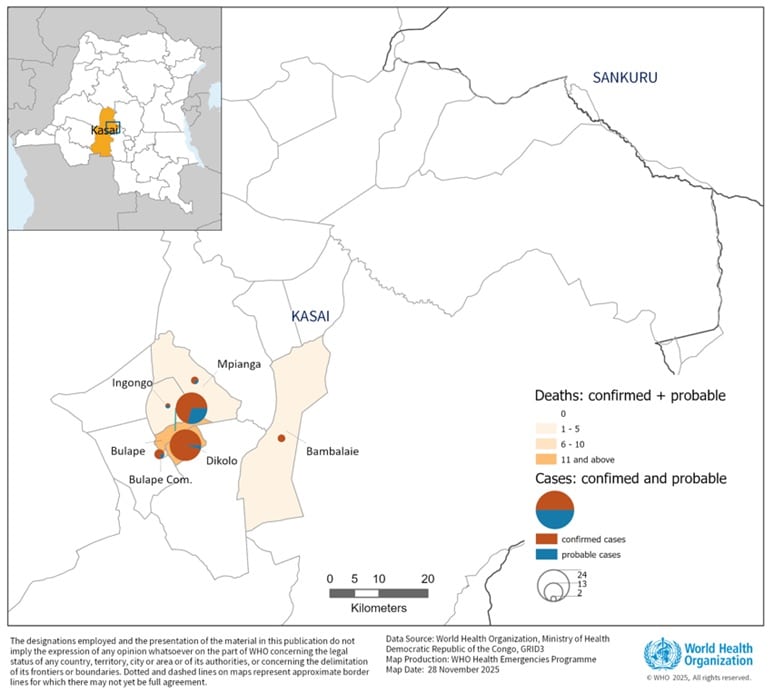Monitoring regional health data in West Africa
WAHO uses DHIS2 to consolidate aggregate health data from the 15 ECOWAS member states into a regional data warehouse
West African Health Organization (WAHO) WAHO is a specialized agency of the Economic Community of West African States (ECOWAS). Its mission is to harmonise healthcare policies and campaigns against priority diseases in the 15 member states (Benin, Burkina Faso, Cape Verde, Cote d’Ivoire, Gambia, Ghana, Guinée, Guinée-Bissau, Liberia, Mali, Niger, Nigeria, Sénégal, Sierra Leone and Togo). One of WAHO’s core goals is to collect and disseminate information on health research; priority diseases; human resources, infrastructures and health funding; related policies; determinants and population health situation. WAHO also support member states to strengthen their national health information systems.
With support from the Health Information System Programme (HISP), WAHO started to establish a regional data warehouse in 2011. The WAHO DHIS2 instance is an integrated data warehouse of essential health indicators that makes compatible health data from all 15 ECOWAS member states. When the integrated WAHO-database becomes fully operational, it will be an important tool for the WAHO to monitor health sector indicators within the region through comparisons of health information across the region and over time. Currently, the focus is on aggregate data related to epidemic-prone diseases and the establishment of the data warehouse has been incorporated under the West African Disease Surveillance and Capacity Strengthening Project (WARDS). The long-term goal is to also integrate routine disease monitoring in the platform.
The open source DHIS2 software was chosen as the platform for this regional data warehouse as DHIS2 was already the backbone of the national HIS in many countries in the region, and thus allowed for direct online integration of data. DHIS2 was also estimated to handle the projected load of health data. Using the same platform regionally and nationally not only enables interoperability between countries but it also serves as leverage for strengthening health information system capacity across the countries in the region.
Background
Prior to the establishment of the regional data warehouse country health information systems in the region was assessed in 2011-12. The assessment showed that many HIS in the region are challenged by inadequate infrastructure, lack of human resources and lack of health information sharing amongst countries but also among stakeholders within countries. Following up on the assessment a regional HIS policy document was developed and approved at ministerial level in 2012. The policy addressed the regional challenges to health information systems by having a strong focus on capacity building, involvement of all stakeholders and the creation of a culture of information use.
The data warehouse

The WAHO regional data warehouse (Figure 1) is online and web based, which means that the information is accessible from anywhere at any time. The data warehouse is implemented using the DHIS2 platform, enabling data analysis and presentation of information through tables, charts and maps. Dashboards are used to create overviews at regional level as well as more detailed views of select areas of the region displaying where diseases might potentially cross borders of neighboring countries (Figure 2).
Currently, IDSR-data from all 15 member states is registered in the WAHO data warehouse. In all countries data is collected at facility level and then aggregated at various organizational levels. The number of organizational levels depends on the health system structure in each country. At national level data are aggregated, finalized and quality controlled before being transmitted to the WAHO data warehouse. At WAHO a quality control is run before data is published in the data warehouse. Feedback is given to countries on timeliness, completeness, and data quality.

WAHO is responsible for producing and publicizing the different health information products as weekly feedback to countries, semi-annual epidemiological bulletin, and annual health statistic report and health status in the region. But countries and other relevant stakeholders can be granted access to the data warehouse in order to be able to make their own analyses. Currently, users of the data warehouse are mainly data managers from the WAHO member states. However, the user group is expected to expand as the data warehouse becomes fully functional.
Lessons learned
Although the implementation of the WAHO data warehouse is still ongoing there are already important lessons to be shared from the process of establishing and implementing the data warehouse. This has been a process characterized by the involvement of a larger number of stakeholders from a variety of countries. Focus in this process has therefore been on creating consensus around regional level practices while at the same time respecting differences at country level. Key challenges and the response to those are listed below.
- Compatibility across countries: Comparison across countries is only possible if the way in which the data is collected and defined is aligned across countries. An important part of the development has therefore been to ensure such compatibility across countries. Core sets of 80 essential health indicators and IDSR indicators have been agreed upon. Furthermore, after reporting to the data warehouse has begun it has become necessary to maintain ongoing discussions on how countries should report on these indicators in case data is collected differently at country level.
- Flexibility to countries individual needs: As the WAHO member countries vary greatly in terms of size and organization of the health sector there is still a need to adhere to in-country reporting requirements. It is critical to also take this into account. For the WAHO regional data warehouse, this has been possible through the development of a flexible integrated architecture that allows countries to keep their unique organizational hierarchies while reporting to the WAHO regional data warehouse in a generic three-tire organizational hierarchy.
- Capacity building in a distributed setting: Strengthening of country HIS is a critical part of the implementation process, since the data quality in the data warehouse relies upon the quality of data being reported from the countries. Such strengthening concerns both updating of national HIS policies, maintaining data base installations and training of data managers and users. Until now this has been organized in two ways; 1) in connection with implementation work through individual country visits and 2) in connection with workshops and meetings that have brought together stakeholders from all countries. However, there is a need to develop a solid framework for continuous capacity building amongst countries.
Information sources
Tomé Ca, in Charge of Health Information Management at West African Health Organisation (WAHO)
Stine Loft Rasmussen, Health Information Systems Programme (HISP) at University of Oslo



